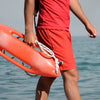How to Clean Your Lifeguard Rescue Equipment?
How to Clean Your Lifeguard Rescue Can, Rescue Tube, Spineboard/Water Backboard, Buoys, etc.
Lifeguard keeps a close eye on swimmers and visitors at pools, beaches, waterparks, and lakes and are ready to jump into action to give life-saving care at a moment's notice. In 2017, the United States Lifesaving Association's Lifeguard performed 75,951 rescues at beaches around the country and provided medical attention and first aid in 546,707 cases.
Lifeguard rely on the correct water rescue and safety Lifeguard Equipment to accomplish difficult water rescues and provide excellent medical care. Lifeguard use a variety of Lifeguard Equipment: Spineboard Kit, Rescue Tube, Rescue Can, and Ring Buoy. Lifeguard rescue and safety equipment requirements vary depending on the water environment and the circumstances. Pool Lifeguard safety equipment differs greatly from water rescue safety equipment for surf conditions and turbulent waves. This article will go over how to clean this rescue equipment.
Lifeguards are required to clean and disinfect any equipment used while providing care. Before doing so, Lifeguard must exercise extreme caution when handling infected material. Soiled garments or towels must be placed in clearly labeled plastic bags for disposal or washing. Isolate the infected area, remove and dispose of any organic materials on floors, counter tops, or any other surface that has come into contact with body fluids with a soap solution and a towel, disinfect the area and/or equipment with a bleach solution (1/4 cup bleach per gallon of water, let it stand for 10 minutes or until dry), and rise. Wear gloves if you're doing this.
Steps in Cleaning Lifeguard Equipment
- When handling these items, wear appropriate Personal Protective Equipment (PPE).
- Perform preparatory cleaning if necessary. Wipe away filth with a clean cloth or brush and wash in a warm water and mild detergent solution.
- Thoroughly rinse with clean water to remove the detergent.
- Sanitize the equipment by wiping it down with a commercial disinfectant (Lysol, Clorox Wipes, or equal). For proper product use, consult the manufacturer.
- Thoroughly dry. A hair dryer or an air hose can be used to dry hard-to-reach areas.
- Dispose of PPE used in the decontamination process properly (gloves, mask, etc.).
- Thoroughly wash your hands and consider using a sanitizing product such as Purell.
Summary
- Differentiate between cleaning and decontaminating.
- Think about replacing equipment vs decontaminating.
- Use an adequate disinfectant/sanitizer.
- Check the manufacturer's recommendations for detergents, disinfectants, and other cleaning agents.
- Be wary of noticeable equipment impacts (color change, "bleaching," strong odor).
- Other factors may influence the outcome (age, method, wear & tear etc.)
- Exercise extreme caution when decontaminating equipment many times (keep a log)

